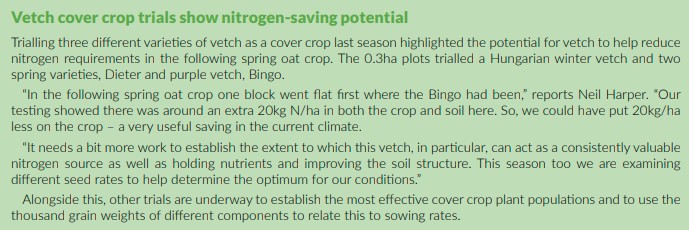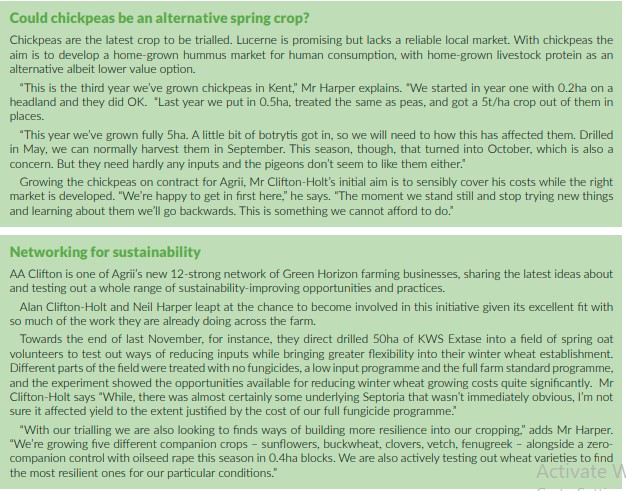Ten years ago Alan Clifton-Holt took the decision to use cover crops to address a multitude of issues across his Kent
rotation. Today, with a decade’s experience behind him, he shares what he has learned with the Direct Driller farming audience. As he says, he has a far better idea of what cover crops can do and how to make the most of them.
Alan Clifton-Holt says that the main value of cover crops on the Kentish land they farm is in developing a soil structure into which he can drill spring crops sensibly, and at the same time providing extra nutrients for the next crop. Parts of the land, especially on Romney Marsh, are under high pressure from blackgrass, and in the mid-2000s he can recall that some of the fields became almost unfarmable, with blackgrass reducing wheat yields to only 5 t/ha.
“We haven’t completely conquered this challenge yet, but we are getting on top of it, having taken some big decisions, these include reducing cultivation passes and depth, incorporating grass leys, spraying off badly infested crops and spring cropping.”
Blackgrass control and spring cropping
Spring cropping remains integral to current control tactics, with a double spring crop break within a six-year rotation that also includes two winter wheats, winter barley and oilseed rape. Surprisingly perhaps, spring barley is not a favoured option. It was found wanting in the whole rotation system being developed. Spring oats and spring beans are now the mainstay spring sown crops, with chickpeas being trialled as an alternative, and cover crops grown ahead of all the plantings.
“With spring crops there are three over-wintering options,” Mr Clifton Holt says. “The first is to leave the ground as a stubble, the second to cultivate it, and the third option is to plant something that can be drilled into. We took the view that the latter option had to be the best way, and it’s working well for us.”
Any cultivations the ground requires are carried out immediately after harvesting each autumn and the cover crop drilled as soon as possible after that. The aim is August, but it can be as late as late September, depending on weather and workloads, he admits.
Over the past three seasons the species mix and agronomy of the covers has been fine-tuned with the help of the latest research and on-farm trials overseen by Agrii agronomist Neil Harper. Drilling large 0.3ha plots of individual species and mixes have been very helpful in providing the best insights here. Their current mix is based on rye, phacelia and linseed. He prefers rye to oats because it’s more prostrate. “Oats can be a bit floppy and hold more water, making the field wetter when you come to drill it.” He says Phacelia is a great plant and that everyone should be growing it. Linseed is another plant that does a really good job of soil structuring and soil improvement if you handle it right.
Following recent trialling with Agrii, the base mix is being tweaked to include a vetch, and buckwheat is also being explored to see whether its phosphate mining ability will help – especially at current prices. Alan says “I was initially reluctant to include vetch, but Neil showed me good evidence there wasn’t any carryover from nematodes or pests that will affect our pulse crops. One of the reasons we took him on four years ago was to access to this sort of well researched support. So, we’ve chosen to run with it.”
Not convinced about sheep grazing in Jan-Feb
Overwinter management differs depending on the following spring crop. For the past two seasons, the cover crops ahead of spring oats have been grazed into January and February with a flying flock of sheep, before being sprayed off with glyphosate predrilling. Mr Clifton-Holt is in two minds about the value of the sheep here. “The head is telling us it’s the right thing to do, but we’re not yet totally convinced,” he admits. “We’re seeing some surface compaction following the sheep grazing – it’s not that they’re being left on the ground too long, but more about soil type. A high silt content means it can cap badly if put under pressure when it’s wet. In which case we’ve found spring cereal yields suffer where we direct drill rather than cultivating.”
Some farmers, he thinks, might argue the capping is because of the cover crop, but he’s convinced the crop is doing the right thing for their soils and is holding nutrients. They try to be flexible with what they do to make the system work. As a result, a light spring tine cultivation now routinely precedes spring oat drilling with a Vaderstad Rapid to remove any shallow compaction. This has improved spring oat performance in the past two seasons. He says “We don’t charge a huge amount for the grazing and while we do get organic matter back through the sheep dung it comes with the headache of compaction, so we’re still in two minds here.
Without the sheep grazing, covers before the spring beans are typically sprayed-off with glyphosate around Christmas to reduce the vegetation. With a surprising amount of re-growth in the base and blackgrass, they are usually sprayed again a week before direct drilling with the farm’s Amazone Cayena. Yields of the spring beans have definitely increased since using the cover crop, and in 2021 they did 5-5.5t/ha and they’re certainly more stable. “We don’t have the variability we used to have. I wouldn’t grow beans without them now.”
They have only ever grown spring oats after covers, so don’t know how much they contribute to performance, but he is happy with the 7-7.5t/ha they deliver and, as they’re on a contract at a decent price, the numbers add up.


